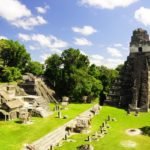A Journey into Ancient Tiberias

According to Kabbalistic teachings, each of the four holy cities of Israel is associated with one of the basic elements of nature. Jerusalem is fire, Hebron is earth, Tzfat is wind/air and Tiberias is water.
Some of these associations seem obvious but, in fact, the relationships are more complicated than they first appear. In the case of Tiberias, one might expect that its position along the shores of the Sea of Galilee/Lake Kinneret provides the source of its kabbalistic link to water, but in fact, the association relates more to the concept of purity than anything else.
A Journey into Ancient Tiberias
History of Tiberias
Tiberias was originally established by King Herod’s son in the 1st century C.E. Herod Antipas built the new city on a site where numerous graves already existed, causing the majority of the Jewish residents of Palestine to refuse to live in the town. In the 2nd century C.E. the great kabbalist, Rabbi Shimon Bar Yochai, visited Tiberias and identified the location of the graves so that the bodies could be reinterred and the city could become inhabitable to Jews.
Following the Bar Kokhba revolt (131-135 C.E.), the majority of Israel’s Jewish population migrated to the Galilee. Many of the great rabbis of the era settled in Tiberias where they established the Great Sanhedrin Court. The Talmud was redacted in Tiberias in the 4th century C.E. During this period Christianity was beginning to evolve and the region’s association with various events of the New Testament drew early Christians to settle in the city.
Throughout the Byzantine era, Jews and Christians lived side by side in Tiberias. Muslims conquered the city in the 7th century. The new rulers introduced Islam to the city, building a large congregational mosque in the city center. Followers of the three religions co-existed within the town for hundreds of years. When the Crusaders conquered Tiberias in 1099 they expelled the Muslims and the Jews. But, after the Crusaders’ defeat in the 13th century Tiberias became, once again, a multi-ethnic city.
To See
There’s no end of sites to see and things to do in Tiberias. There are numerous archaeological excavations and ancient sites where you can get an overview of the Jewish, Christian and Muslim histories of Tiberias. Many artists and craftspeople have established studios and galleries in and around Tiberias.
South of modern Tiberias, near the foot of Mt. Bernice, is the site where the city center of ancient Tiberias was once situated. The archaeological site, which is still under excavation, displays finds from almost every period of Tiberias settlement, beginning in the first century and extending through the Crusader period. In the 12th century the Crusaders moved the city several kilometers to the north.
Berko Archaeological Park
The ancient buildings in the Berko archaeological site, north of the early site, include a large basilical structure which dates from the late Roman and early Byzantine period. This building may have been the seat of Jewish leadership, the Sandhedrin. In addition you can see remains of a Late Roman Byzantine bath-house which continued to be used throughout the Early Islamic period. There is also a temple wall, which has been identified as part of the Hadrianaeum Temple, which was built in honor of Roman Emperor Hadrian. The site includes the remains of a Byzantine-era church and the remains of the city’s 8th century mosque. Archaeologists have also uncovered the city’s main street from the Early Islamic period and remnants of the Crusader-era sugar industry.
Mt. Bernice
Christian visitors will enjoy a meaningful visit at the Byzantine monastery and church on Mt. Bernice. The mountain was named after Julia Bernice, the sister of King Agrippa II and an early convert to Christianity. The monastery towers above ancient Tiberias near the ancient city wall with a spectacular view of the Galilee, the Golan Heights and the Sea of Galilee.
Hammat Gader
Ancient kings and emperors, Talmudic rabbis and early Christian leaders all recognized that the spring waters of Hamat Gader had special healing properties. There are numerous ancient writings, going back as early as the Greek era, that attest to the site’s popularity. The Hammat Tiberias National Park is located approximately 20 kilometers southeast of Tiberias. Visitors can see the remains of the ancient town of Hammat. It’s where a synagogue from the Late Roman–Byzantine period displays a beautiful mosaic floor. In addition to the synagogue are the remains of an Ottoman-era Hammam (bathhouse complex). The Hamat Gader springs have been channeled into a modern spa with both indoor and outdoor facilities. There is also a crocodile farm at the site.
Sea of Galilee/Kinneret
The Kinneret, also known as the Sea of Galilee, is Israel’s largest fresh water lake. The Sea of Galilee is an important site to Christians who believe that this is where Jesus walked on water, fed the multitudes (with fish) and turned water into wine. There are numerous sites around the lake where these miracles were said to have occurred but for anyone who simply wants to enjoy a dip in the lake. The beaches of Tiberias offer clean, safe swimming opportunities. The beaches are monitored by lifeguards. In addition, the Luna Gal water park is located across the Kinneret on the eastern side of the lake. It’s directly across from Tiberias (approximately a half hour drive).
Laurie Rappeport lives in Safed in northern Israel. She enjoys exploring northern Israel and writing about her travels. Laurie teaches about Judaism and Israel to distance learning students in the United States. She is presently involved in expanding experiential educational models in the Israeli school system and bringing the System for Teacher and Student Advancement program for teacher mentoring to Israel.
Photo credit for A Journey into Ancient Tiberias by Unsplash.








